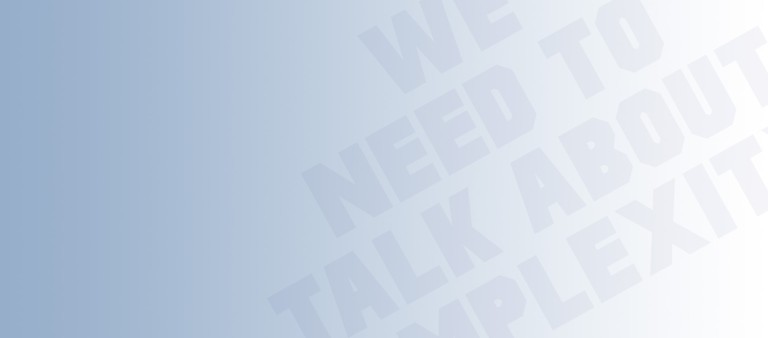Exploring complexity
![{[downloads[language].preview]}](https://www.rolandberger.com/publications/publication_image/roland_berger_think_act_magazine_navigating_complexity_cover_en_download_preview.jpg)
Don't miss our article with Nobel Prize winner Richard Thaler, as well as much more food for thought.


by Bennett Voyles
illustrations by Mario Wagner
Linda Hill says it’s time to forget about "a-ha moments". To turn an organization into a world-class innovation machine, today’s leaders should focus on the genius of collective discovery.
After following over 30 executives of innovative companies for several years, Linda Hill and her team came to the conclusion that our conventional view of what it takes to lead an innovative company is wrong. Forget charisma and "eureka moments" – Hill and her co-authors argue in Collective Genius: The Art and Practice of Leading Innovation that the most important role played by leaders profiled in the book, executives at highly innovative organizations like Pixar Animation Studios and Google, is to create an environment where employees feel free to make suggestions.
The winner of the 2015 Thinkers50 Innovation Award and, alongside her Collective Genius co-authors, the 2015 Warren Bennis Prize for Excellence in Leadership as well as the 2015 Axiom Business Book Award Gold Medal for the Best Book on Leadership, Hill argues that the most innovative companies have leaders who focus on creating an innovative culture rather than pursuing a particular vision.
In a conversation between classes at Harvard Business School, the professor of organizational behavior talked with Think:Act about the kind of leadership that can turn a company into a world-class innovation machine.
All the people [we] studied were visionaries. They were perfectly capable of visionary leadership, and in fact one of the challenges they faced was making space for other people. But the leadership function they served was to build an environment that encourages people to innovate. Fundamentally, these leaders understood that innovation is mostly a bottom-up activity. It’s rarely the result of some individual "a-ha" moment. It really is a collaborative and discovery-driven, iterative activity. As the leader, I will create psychological safety and be supportive to encourage the sharing of ideas, but also I will be challenging so that those ideas are refined to meet our performance objectives. Yes, we have to learn and experiment, but eventually we have to produce. We might improvise, but we have some structure in the organization so we all have some clarity about our responsibilities and also guardrails or boundaries within which we must work.
"It’s not enough to be what we call a ‘value-creator,’ you also have to be a game-changer."
The question of metrics for innovation is one that I don’t think anyone has really nailed. This is an area that boards have talked a lot about with me, but it’s not clear what the metrics should be. Some use things like vitality indices – what percentage of our revenue is from new services? – but a lot of them are using process milestones or non-financial metrics (e.g., increased insight about "stickier" relationships with the customer), because they know that a lot of metrics are too short-term to be meaningful.
Yes and no. When we talk to many CEOs, they say: "The board wants us to innovate, but if we miss our quarter, we’re going to be in big-time trouble." The company’s ownership may affect the attitude as well. One public company CEO was telling me recently that he worries about the rise of passive versus active investing and the impact it has on innovation. Passive indices, he feels, actually might be leading CEOs and boards to be even more short-term oriented and discourage investment in breakthrough innovations that may not pay off for years. If you have a Warren Buffett or a shareholder who intends to hold your stock for the long term, then you have someone you can talk to about your strategy and manage their expectations.
We’ve done a number of interviews with CEOs and directors but we’re still collecting data. So far, it seems that that is the case because the private companies seem to find it easier to think more long-term. The capital is often more patient. In fact, one of the CEOs we talked to, his company went private so they could be more innovative.
Innovation is actually hard work. You can’t force somebody to innovate; they have to volunteer, which is why you have to work to create a context that makes them willing. We found the heart of that willingness is a sense of collective purpose that animates the work and helps them in the face of missteps and even failures. The CEO we studied in the luxury brand business believes luxury impacts how people define who they are and what matters to them. She wanted to create a luxury brand that led women to feel empowered and not, as she put it, like "concubines." There was a purpose to the work that served as a compass for how they made certain business decisions, as well as helping employees find meaning in their work.
Well, innovation was central to the brand identity in one company we studied. And if the brand is about innovation, then everything about the brand needed to be innovative. Brands are built, as the executive put it, from the inside out. So as he told us everything had to be innovative about the brand, not just product design. Having said that, even innovative companies set up guardrails within which the organization works. You may come up with an idea and maybe it is new and exciting, but if it doesn’t fit the brand proposition, then it is not implemented. An innovation is something that is both creative and useful.
No. Co-creation with the customer can be exceptionally fruitful for companies as it makes it more likely that it will meet the customers’ needs and facilitates better execution. For instance, an insurance company we are studying has begun to include customers in their design thinking workshops to develop new online services. By doing so, they are learning a lot about what customers (Baby Boomers versus Generation X) actually value and will pay for and how to best deliver those services to different customer segments.
Many companies are also partnering with suppliers for the same reason, to come up with new processes that improve their mutual operations. One executive who runs a supply chain of a major company is creating what he refers to as an "innovation ecosystem." In an effort to be more customer-centric, together they are completely reimaging the supply chain. Among other things, the new open architecture makes for more transparency for quality control and efficiency for all with its "plug and play" design. He is also working with competitors in the industry to see if they can’t develop standards for more of their work, like what we saw with electricity providers decades ago, that make it easier for all to collaborate and develop better outcomes for the end customers.
We live in a very unforgiving global economy. It is hard to grow and thrive without innovation. For sure. Technology is driving the need to be more innovative, as are employee expectations, and I’m being invited to give lots of talks about Collective Genius, not only because companies want to innovate more, but also because they are eager to build corporate cultures that will help with talent management.
A lot of the speeches I’m asked to give are for people who are trying to figure out how they can retain and unleash the diverse talent they have. As one of the leaders we studied said: "People don’t want to follow me to the future, they want to co-create the future with me." Although he was talking about innovation, what this leader said is something we know from other research on Millennials – they want to co-invent, not follow. We know from a growing body of research that purpose and having impact matter a great deal to them in particular, but also to top talent no matter the generation. Without diversity, you rarely get innovation. So companies are also asking us to share any insights we have about how to build more inclusive cultures in which people of diverse thought and demographics can flourish. I do think innovation matters more today – to differentiate, and to grow. It’s not enough to be what we call a "value-creator," you also have to be a game-changer. If you’re going to deal with the "coulds" and not just with the "shoulds," you have to be prepared to lead change and innovation.

![{[downloads[language].preview]}](https://www.rolandberger.com/publications/publication_image/roland_berger_think_act_magazine_navigating_complexity_cover_en_download_preview.jpg)
Don't miss our article with Nobel Prize winner Richard Thaler, as well as much more food for thought.
Curious about the contents of our newest Think:Act magazine? Receive your very own copy by signing up now! Subscribe here to receive our Think:Act magazine and the latest news from Roland Berger.


